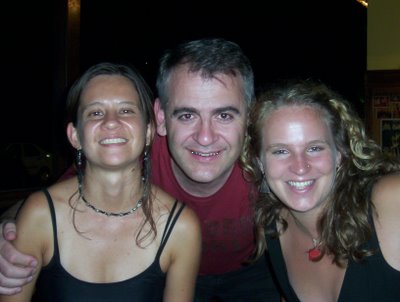Monday, November 27, 2006
WHRC work in Brazil in the news.
How many nationalities does it take to successfully celebrate a birthday?
Answer: 6. Two Germans, Three Brazilians, an Austrian, a Guatemalteca, an American, and the Colombian Birthday Girl.
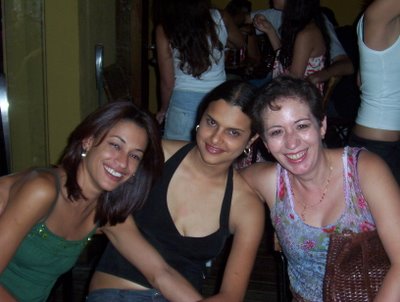
From left to right: Graça, Suzie, Ehidee
On Saturday evening we celebrated Ehidee’s birthday in a diverse array of Portuguese accents over some Birthday beers, and some traditional Brazilian guitar music which then transitioned into eighties covers when they ran out of Brazilian favorites. The group was quite an interesting mix: The Brazilian-born son-of-two-Germans spent most of the evening trying to elicit some sort of reaction from Carmen, the Guatemalteca. In addition to taking advantage of every opportunity to have his picture taken with the two of us (see below).
The Austrian owner of a Brazilian microbrewery was quite happy-go-lucky, and I learned much about the .5% of the Brazilian beer market which is comprised of microbreweries. He confirmed my assessment of the fact that there are, in practicality, no imported beers in
The younger German spent some time complaining about his headache, but seemed to be enjoying texting enthusiastically (rather more than conversing with the diverse array of female company). At one point Ehidee turned to me and said: “¡Me encantan los hombres que prefieran jugar con sus celulares que conversar con la gente!” (“Don’t you just love men that prefer playing with their cellphones to actually talking to people?”) I promptly burst into laughter and responded “¡Como no!”(“How could you not?”) He did not look up.
Ehidee had already informed me about Suzie’s same-sex preferences, but Suzie also decided to inform me herself. The conversation went as follows (a rough translation from Portuguese).
Suzie: “I want to tell you something…..I’m a lesbian.”
Me: “I know. No big deal—she (Ehidee) told me.”
Suzie: “At first when I saw the rainbow flag in your room, I thought….”
Me: (laughter)
Suzie: “But then I figured out it was just a peace flag.”
(laughter)
Suzie: “It’s ok: I’ve already been with an American.”
Me: “And?”
Suzie: “It was boring. The only thing she knew how to say in Portuguese was “você e muito bela—“it got old.”
Lessons of the evening:
Don’t hand your camera to a drunk German/Brazilian unless you are willing to relinquish it for a while.
If you’re going to try to seduce someone of either sex, you’d best learn how to tell them something in their native tongue other than that they are attractive.
Friday, November 24, 2006
thanksgiving
a) make me feel extremely thankful for being continuously blessed with good health
b) provide me with plenty of time to lay around (nonmoving) and think about the many friends, family and opportunities with whom/which I am richly blessed
c) read a favorite book
d) pretend my mother is there telling me to gargle with salt water (yes, mom, I did.)
Thursday, November 16, 2006
Fruit.
 Do not be fooled. The fruit below may appear to be pear-like, but it is a Goiaba, or Guava. It is one of the most delightful fruits ever, at least in my humble opinion. There are red and white varieties in the grocery store here, and they are both fantastic. The red variety provides for a lovely aesthetic experience while munching, but the white is tastier, I think. I especially like the crunchy seeds surrounded by sweet inner core of goodnes, with a tart, granny-smith-like exterior 'mantle'. If you do not already feel good about Guavas, note that they are high in fiber and in Vitamin C!
Do not be fooled. The fruit below may appear to be pear-like, but it is a Goiaba, or Guava. It is one of the most delightful fruits ever, at least in my humble opinion. There are red and white varieties in the grocery store here, and they are both fantastic. The red variety provides for a lovely aesthetic experience while munching, but the white is tastier, I think. I especially like the crunchy seeds surrounded by sweet inner core of goodnes, with a tart, granny-smith-like exterior 'mantle'. If you do not already feel good about Guavas, note that they are high in fiber and in Vitamin C!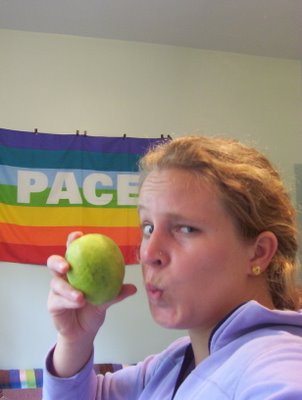
The tomatoes here, however, do not hold a candle to the tomatoes we get in VA. Even the less-than-ripe, character-less ones you get in the Kroger or the Food Lion. Sorry, Brazil.
Tuesday, November 14, 2006
A troubled post about the fate of Hydrochaeris hydrochaeris in Belo Horizonte
On Sunday I went out for a walk. On the way back towards my house, I notice a large brown animal on the trash-strewn shore of the lake. I knew immediately what it was, given my near transformation into one during my several months researching and caring for them in Ecuador: a capybara. I stopped and took out my headphones. I stood perfectly still for several minutes, staring intently at the body to see if there was any movement from breathing--but there wasn't. I must have looked upset; a man stopped next to me and said "it's a capybara!" "Yes," I said, "it is a capybara." "Is it dead or alive?" He asked. "Dead, I think," I said. He was convinced that it must have escaped from the nearby zoo. "they don't live here!" He said. I started to try and tell him that they might, actually, live in the lake...and then decided it wasn't worth it. He would have no reason to believe my word on that one, and probably would not have believed me if I told him I had spent a whole semester researching the animal.
The very sad part of this is, that the capybara was probably, up until it's demise, living happily in the Lagoa da Pampulha until it ate something toxic or suffocated in the incredible stinking matt of algae covering the grassland on the edge of the lake. The body was still there yesterday and I am too angry and sad to write anything else about it. Here is a happy picture of some very sweet domesticated capybara, for old times' sake:

Monday, November 13, 2006
“That’s not a tree; it’s a carbon stock!”
(This one is for my Dad—who I fear, if he didn’t know me as well as he does, might be convinced that I really believe that everything in life is economically quantifiable.)
It is 2015: a sunny October Saturday in an urban neighborhood of
They are meandering down a path in a picturesque wooded area. They all yell for the dog as he bounds off after a rabbit—the children play tag and roll in the leaves. The father summons the children (ages 8 and 10) over to talk to them about the stately, historic red oak that borders the path (with a small plaque designed by a Virginia Tech student), saying: “Come here and let me tell you about this tree!” The boy, age 8, pipes up knowingly: “Dad, that’s not a tree! It’s a CARBON stock!” Confusion flickers across the father’s face as his mind takes him back to freshman biology lecture, most of which he realized then that he had slept through. He rumples his child’s hair and says: “Well, I guess you are right, son. It is a carbon stock.”
Return to the present with me. This weekend I have been translating a document into English by a colleague here at the University for the Woods Hole people to take to the global conference on climate change taking place soon in
But indeed, what are our options for visualizing something as vast as a forest resource? Our new technologies and incredible amount of knowledge allow us to predict and quantify the movement of something so intangible as Carbon—something that escapes into the atmosphere when we set fire to it, gets tied up in trees, powers our vehicles, and somehow contributes to the warming of our planet over time.
I suppose, at a personal level, I question our ability to balance this view of quantification of the earth’s services while still retaining the wonder that we experience when we walk in the forest, and the rich historical tradition of peoples that have, for centuries, been dependent on the forest.
Ecologists and economists both think in green, at least with respect to forests. As an economist, the idea that I could go walk around in the forest if I wanted to is worth something to me. As is the idea that there are people still running around with bones in their noses and hunting still-present monkeys with poison blow darts. And what I would or have actually paid to do these things is probably the best measure that we have for what they are worth, in terms of their ‘use value’. But is that really all there is to it?
How do we keep humanity seeing green, feeling green and doing green? And I don’t mean merely appreciating the fact that the rainforest ties up carbon that would otherwise be contributing to global warming (and threatening the long-term viability of our race). Not just realizing, with a warm sense of satisfaction, that our annual contribution to the Nature Conservancy gives us a 10% discount if we should ever want to go fly fishing in
When I am able detach myself from economic valuation mode, if you will, I am able to think about my own experience and how it has led me to thinking in green (economic terms) in a belief that this will leave us with the prospect of being able to see green, feel green, and do green well into the future. I find that my wanting to learn to think in green is a direct result of my taking part in, for many years, the more tangible, perceptual and emotional greens (seeing, feeling, and doing).
As a child, I would climb the hill behind my house to watch the sunset from the top of a red cedar tree. I would wander the ridge, wondering what the enormous piles of stone were that were covered in leaves—I used to think they were Indian burials until someone wiser informed me that they were the stones that had been removed during the plowing of the fields, which I found a very practical explanation. I remember wondering what I was going to tell my parents after I wrapped our family canoe around a tree in the
Insect and leaf collecting in Mary Ann Angleberger's Biology class. Riding my horse alone in fields full of cows. Hiking down the
I could go on—but here is my simple point: there is a history and a future associated with every landscape. A history of natural evolution which is enough to inspire belief in God among cultures everywhere. A human history that shaped and was shaped by the landscape. A personal history—the history created as a result of the time that I took to interact with my landscape—to let it shape who I am.
I have chosen to embrace economic logic, to believe in the power of thinking in green. I have not, however, had to relinquish seeing, feeling, or doing green to embrace this economic paradigm. I will even argue that there is a mysterious element of synergy—that because I allow myself to explore the limits of economic paradigms through my own experience, I am forced to continually challenge myself to think critically and creatively about the ways in which we can think, in green, for the welfare of our own and for that of future generations.
The fact is, a hypothetical ability to visit a national park, memorization of statistics about global carbon, or how much I might be willing to pay (or have paid in actuality) to see an endangered species, are only peripherally related to what inspires me to see, feel, or do, in green. Only an actual visit—a visit to the classroom of the outdoors—will open me to being drenched by a thunderstorm or startled by a rattlesnake, to being moved to tears by a sunrise. And only this openness to change the ways in which I interact with the world through the lessons of my own experience has inspired—will inspire—these three things in me. And this, my friends, is a process that even the most creative of economists would find difficult to model or quantify.
Thursday, November 09, 2006
Of cockroaches and heels: balancing vanity with practicality.
Two events this week h
This p
So,
My im
The tre
No sooner h
As for cockro
Or, m
I h
Monday, November 06, 2006
Paratí, RJ
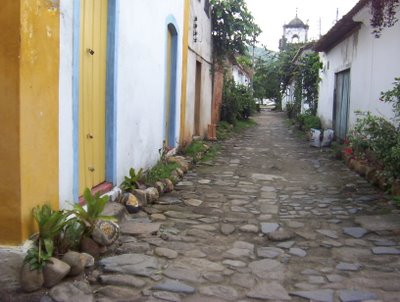
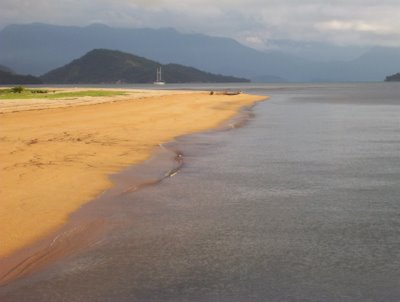

 Caipirinha followed by espresso
Caipirinha followed by espressounavoidable mud between cobblestones
mirroring the unavoidable rain that hovers over the mainland
sharing of space and sunscreen with brazilian teens and brazilian babies
on beach and on boat
that finish one beer with the purpose of beginning another (the teens)
that stare, and smile (the babies)
The islands look best from above, from the back of a horse
with a couple other brazilian adventure-lovers
as if you could place yourself in the stream and end up in the ocean
the vet teaches me about bot fly larvae and how to remove them,
and demonstrates on a black dog
(lacking pictures of the horseback ride--tradeoffs between freedom and carrying a camera...)


